You may notice that sometimes Zebra Finches are given the tages English, German, and American. This is a broad categorisation which relates to size. “American” birds are the most true to their wild counterparts, retaining pretty much the same dimensions, whereas the “English” and “German” charities tend to be larger, bred for shows. This bulkier variety of finch is often referred to as a “cobby” by breeders. In general “German” birds tend to be larger than the “English” birds, though these categories are very broad and not all that useful for categorising this species.
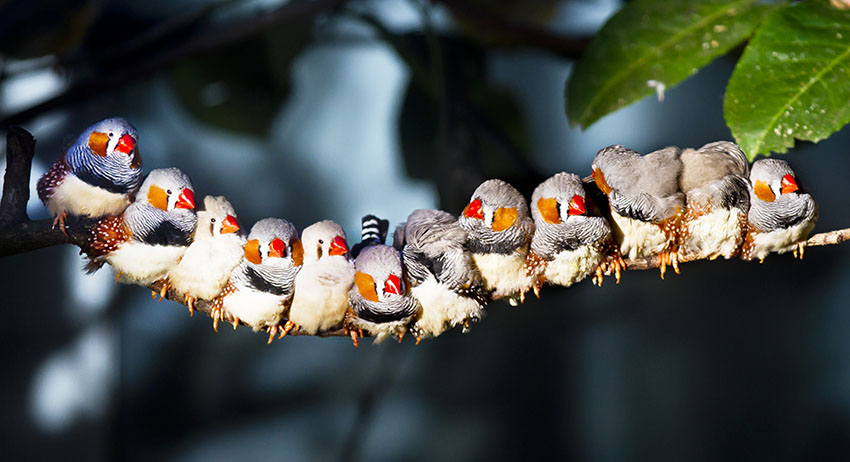
Zebra Finches - English, German or American?
Selective breeding has produced many colour varieties of Zebra finch. Basically, the birds can have one of two background colorations - Standard (Grey), or Fawn.
Zebra Finch Colour Types
Each of the following is recognised as a distinct variety at bird shows. These are all colors set against a background of three basic varieties - Grey (standard), Fawn or White.
Standard Type, or Grey
This is just the classic Zebra Finch we all know and love, retaining the same colors as their wild cousins.
Black-Breasted
These birds differ from standard birds Greys in most plumage details. Their large black breast marking is, of course, what gives this variety its name. They have much larger cheek patches and seem to lack the traditional Zebra Finch “tear” stripe under the eye. The spots on their flank are also much larger and stretched out, oftentimes producing a strekaed or spotted effect. This bird has different tail plumage too, and there may be orange or white flecks on the wings. The Black Breasted is often used in breeding and is frequently crossed with other types of Zebra Finch. If your bird has a wide black splodge on its chest, it's at least somepart Black-Breasted Zebra.Black-Cheek
As the name would suggest, these birds have pronounced black cheeks. These black cheeks mask the “tear” stripe that sits alongside it. Another feature that this bird has which isn’t present in the grey variety are the black flanks they sport, whereas a grey would have chestnut colored flanks. Black-Cheeks are often crossed with other varieties to combine key plumage features. This mutated version of the grey was first noticed in the late 1970s. The black cheek isn’t a very robust genetic feature and breeders often have trouble getting the markings dark and distinct.
Black-Face
This variety of finch has a much darker face than the standard grey type. This black plumage is across their breast too. The extent of this dark plumage varies from bird to bird, sometimes the black color can stretch across the whole underside from chin to vent. The effect is much more pronounced in cocks, some Black-Face hens can be hard to distinguish from the standard grey type. This variety is often crossed with the Black-Cheek and Black Breasted types to produce a much more pronounced black coloring. If crossed with the Orange-Breasted variety, the blacks and oranges vie for prominence.
Certain breeders in Australia have pushed this coloring to the limit, creating a very black bird referred to as the Black-Bodied zebra finch; though this variety isn’t officially recognised as separate from the Black-Face.
This variety is restricted to Australia. They were first developed in the 1960s. In terms of appearance, this variety looks very similar to the standard grey, but they have an extensive black area running from their throat across to the flanks. Unlike the similar looking Black-Breasted variety, the Black front zebra finch has thick tear stripes on the face.
Chestnut-Flanked White (CFW)
This variation has a white body with brown flanks, though these flanks are often not present. The standard head and breast markings remain intact, though in some individuals these markings can be much more faint than in the grey type. The tail of the CFW is a light brown or grey color, depending on whether the bird is from Grey or fawn stock. The head colors also tend to be much less striking than in standard birds. Some are predominantly white, though a certain amount of pot luck is involved in breeding this variety.
This variety is further split into two more types - the Regular “old” CFW (also known as the Black-eyed or UK CFW) and the Continental or “new” CFW (also known as the Red-eyed CFW). The continental variation has darker bars on its tail and a creamy tinge to the back - not to mention the distinctive dark red eyes that they sport.
By crossing different variations, breeders have come up with other complex variations on the CFW, including the Black-Breasted, Orange-Breasted, Black-Cheek, Fawn and Lightback CFWs
The gene responsible for the crest is very often combined with other varieties to produce crested variations of whatever variety it has been bred with. In the “ideal” crested Zebra Finch, the crest is a circular tuft of feathers on the bird’s crown, though sometimes it can be reduced to half a circle, a few upturned feathers or just a general scruffy look to their crown that somewhat resembles bed-head.
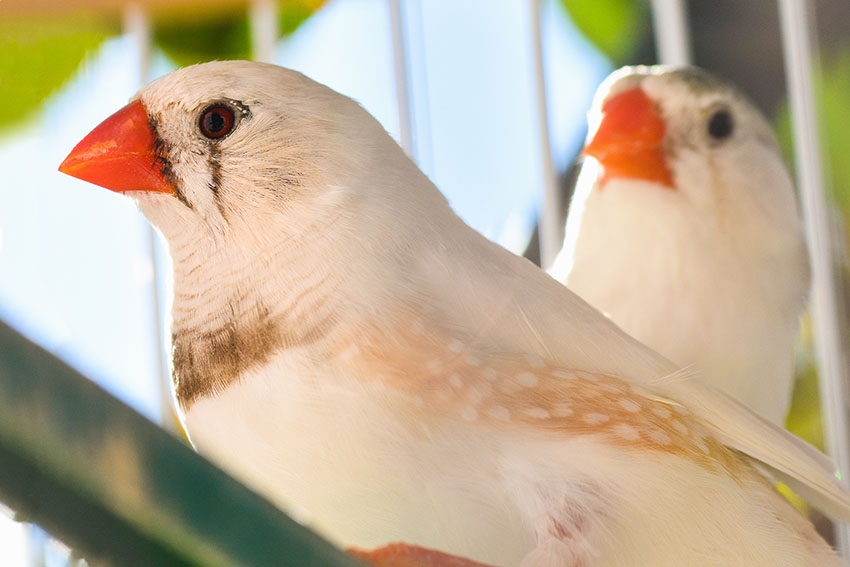
American Chestnut Flanked White finches
Eumo and Charcoal
These are two very dark variations of the Zebra Finch. They have a noticeably silky look to the wings, this is a direct result of the feather barks not interlocking. Whilst this may be very pleasing to the eye, it actually hinders the bird’s natural ability to fly. These two variations look very similar, the difference being that the Eumo is from Europe, whilst the charcoal variation comes from Australia.
These birds have much less melanin, the pigment which causes darker coloring, than the standard types. This turns the grey and black colors to fawn (light brown) and dark brown. Usually, the cocks have a slightly lighter color than the hens, especially on the cheeks and along the flanks. Males can also sometimes have off-white, buff tinged bellies instead. Hens almost always have the buff coloring. Young Fawn birds have lighter skin than standard chicks, this is yet another sign of the low melanin levels.
The fawn gene has been used a lot in cross breeding to create a mixture of different patterns such as the Black-Breasted, Silver and the Orange-breasted Fawn. If birds are exposed to a lot of sunlight, they can suffer from faded or “bleached” feathers, producing a blotchy, pied look. This is harmless and the original colors return after the bird moults, meaning that this plumage is not a distinct variety.
The fawn variation of Zebra finch often has fluffier feathers than standard birds, this is a feature known as buff. This often causes markings to be less distinct, meaning that they tend to be less popular with breeders intent on showing their birds at exhibitions.
Fawn Cheek and Grey Cheek
In this variation, the grey or fawn feathers (depending on the base color of the bird) are faded out to white or an off-white shade. The bird’s cheek patches retain the base body color. The markings on the breast are faded as well.
Grizzle
This variation has white flecks all across their plumage. These flecks create a so-called “salt and pepper” effect. Some individuals have white crowns too, these are often called White-Capped Grizzlies. This variety first appeared in Australia in 1959,
Isabel and Florida Fancy
The black colored pigment eumelanin is completely absent in these types, this makes the orange and brown markings across the head and flanks noticeably stand out against a background of all-white. Some individuals can have a silvery sheen along with a creamy brown belly.
The difference between these two types is all down to genetics. The gene which causes the absence of eumelanin is dominant in the American bred Florida birds and recessive in the European and Australian bred Isabels (this means that it won’t manifest unless matched with another recessive gene).
Both varieties were unveiled at exhibitions in the 20th century. The Florida type simply gets its name from the place it was first unveiled, Tarpon Springs, Florida. The name “Isabel” is a bit more complicated, whilst on the surface it may seem pretty simple, as Isabella or Isabelline is the name for an orangey-brown color, much like the one this bird sports across its head and flank. In reality, the name is actually a rather unsavory historical joke. It refers to Queen Isabel, who once wore the same pair of underwear for months on end as she insisted that she would not change them until a certain siege had been won. Once finally won, the undergarments had turned “Isabelline”.
The Queen in question is actually thought to have been Clara Eugenia, Queen of the Spanish Netherlands. The vow is supposedly related to the three-year long siege of Ostend. But the term “Isabelline” had been thrown around before this, and is more likely a reference to Queen Isabella of Castile, with the siege in question being the eight-month long siege of Grenada.
Lightback
Superficially this variety looks like the standard Grey type. However, their heads, wings and backs are silvery grey, much lighter than Greys. They also have bright white bellies and tail coverts, and lighter cheek patches and flanks (diluted to an an apricot colour). They have been combined with other varieties to produce complex variations such as Lightback Black-cheek, Black-breasted and Orange-breasted birds.
Orange-Breasted
These birds have orange instead of black markings on the breast, throat, tail and "tear" stripe. This stripe doesn’t stand out like a black stripe does, as it sits beside, and merges into, the orange cheek patch. The birds are frequently crossed with other types to produce Orange-breasted Lightbacks, and the seemingly contradictory Orange-breasted Black-breasted, in which the black sits at the heart of the extensive orange chest markings. Orange-breasted Black-breasted Fawn types are the most orange of the varieties, the colour merging very effectively with the light and chestnut browns of the underlying Fawn coloration.
Orange-breasted Zebra finches are a recent mutation, first cropping up in Belgium in the late 1970s. Some breeders make it their life’s ambition to produce birds with all orange and no black markings on the breast, a fiendishly tricky task.
Penguin
The Penguin Zebra certainly wins the prize for best name. “Penguinism” is a mutation that suppresses the melanin pigment, the pigment responsible for darker coloring - this causes any greys and blacks on the finch to be removed. Orange coloration on the cheek patches and along the flank is still present, but the breast bar and tear marks are noticeably absent. This Penguin effect is most commonly combined with the Black-Cheek variation.
Pied
This variation has random patches of white which block out the usual barkings. These patches are spread all across the body. Many breeder dislike this effect and will tend to avoid breeding a bird that has even a single out-of-place white feather. If a pied finch is bred with another pied finch, the effect only gets stronger. As the generations go on, little of the underlying color shows. The last markings to go are on the back. Birds that sport this finla little splash of color are called saddlebacks. The desired result of this pied x pied generational breeding is an all white bird.
Silver
These Finches sport a silvery sheen across all their body feathers, ending up in a faded, pastel effect. The are often crossed with the Fawn type to prudence a variation called the Dilute Fawn, or Cream. In said birds, little remains of the standard colors.
The silver trait can be both dominant and recessive. In birds with a dominant silver gene, pigment across all its colors are reduced whereas if a bird carries a recessive sliver gene, only the blacks and greys get faded, and the orange remains vibrant. The effect on the colors can sometimes be blotchy, a trait which most breeders try to eliminate. An egg containing a chick that has received dominant sliver genes from both its parents will not hatch - this is just one of the many complexities of selective breeding.
White
In this particular variation, all feather pigments are absent. This results in an all-white, almost albino looking, bird. Depending on which birds they are derived from, this type can sometimes have very faint grey markings on the head and breast area. Their orangey-red beaks and legs stand out in contrast. Some “whites” may not be whites at all, but actually Pied finches that have had all of their colors bleached out.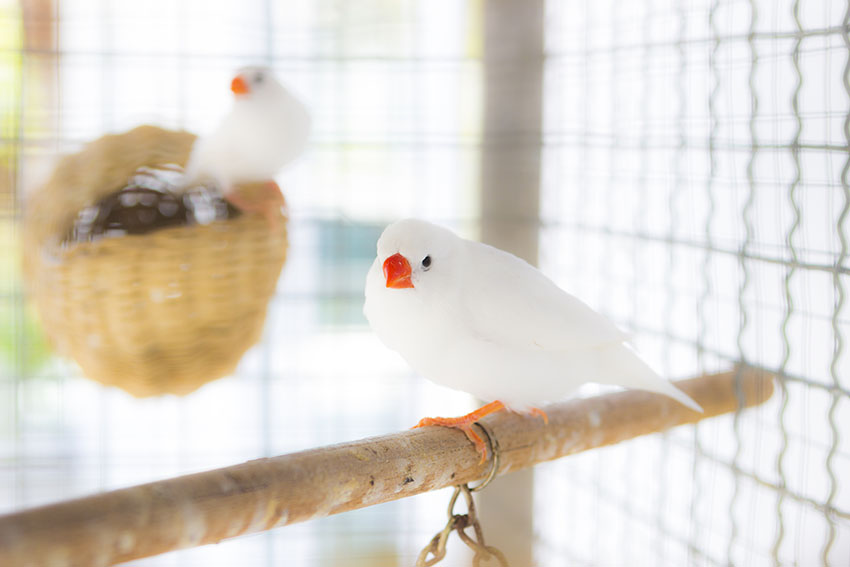
White Zebra Finches
Yellow Beak
Birds carrying this gene sport a white or light orange beak as opposed to the usual red ones. This type can be found in the gene pool of all types of pet Zebra finch, though they are most highly prized in white birds.
Zebra Finch Hybrids
As mentioned before, there are several different subspecies of Zebra Finch. These subspecies will happily cross-breed, so breeders tend to keep them separated. They are, very occasionally, bred together to create hybrid birds, though since the early 20th century, fascination with hybridization has waned. Whilst hybrids are in fact fertile, in the show scene they are almost of no use as most of their distinctive markings are lost.Zebra Finch Hybrids
Zebra Finches can even be crossed with their closest Finch Relatives, such as the Double-barred and Bengalese Finches. Again, this is rarely done and it is very unlikely you will come across such birds. What this tells us is that various species of Estrildid Finch are actually very closely related and acts as a reminder of the seemingly endless variation and diversity thrown up by evolution.


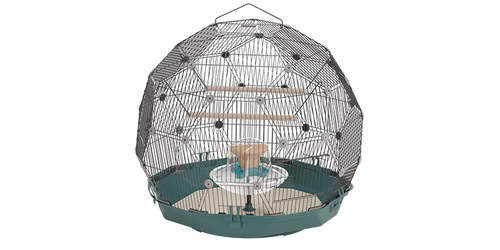
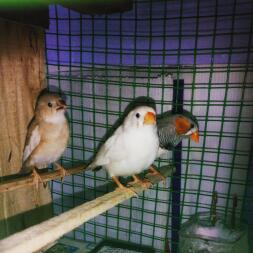
Comments
An Omleteer, 13 December 2024
Hi i have 2 normal male zebra finches and 2 white zebra finches and woundering how to tell the diffrence between male zebra finch and females
Jakobie, 28 December 2022
I have some finches I'm trying to sell, but I'm not sure where to start. Any suggestions are most welcome.
Andrea, 27 June 2022
Hello, Where can I purchase a crested zebra finch?
Deborah, 18 September 2019
I have 6 finches, 2 of them males I was told they are all zebra type, my solid white male and classic orange patch one are best friends I'm wondering why neither male have not tried to mate with the girls.the girls all have that. Crown of feathers in a disarray on top, could my girls be society finches instead of zebras thus causing the males not mating with them? Thanks for your thoughts
Diane, 25 August 2019
I have 2 fawn finches Male and female. One grey female and a black cheeked Male. They all get on in a massive indoor cage. Night time the black cheek Male is really spiteful to the female grey and will not let her in the nest box at night. The grey female has just got its beak turning orange so she is only young. She so much wants to sleep with them all. What do I do